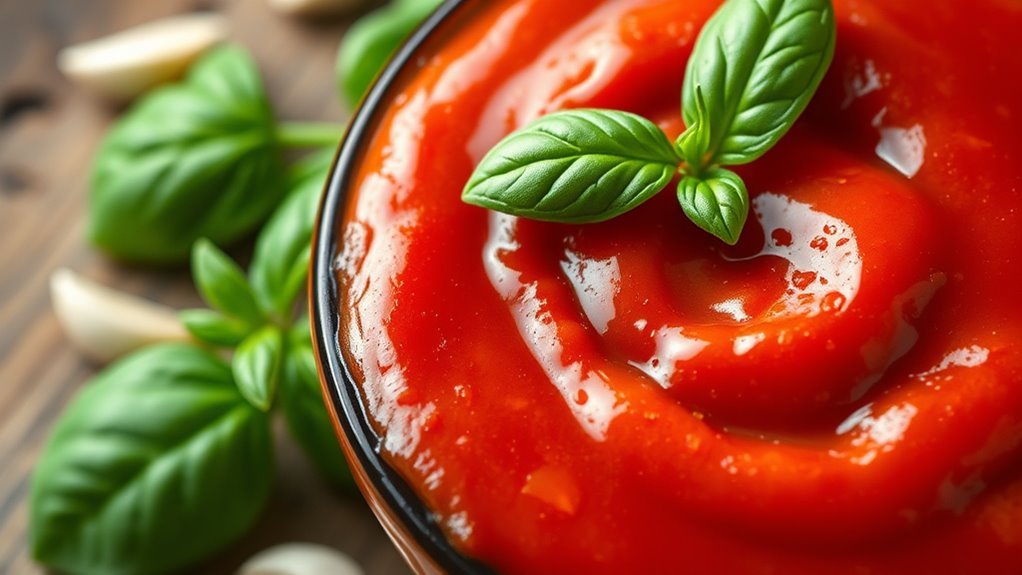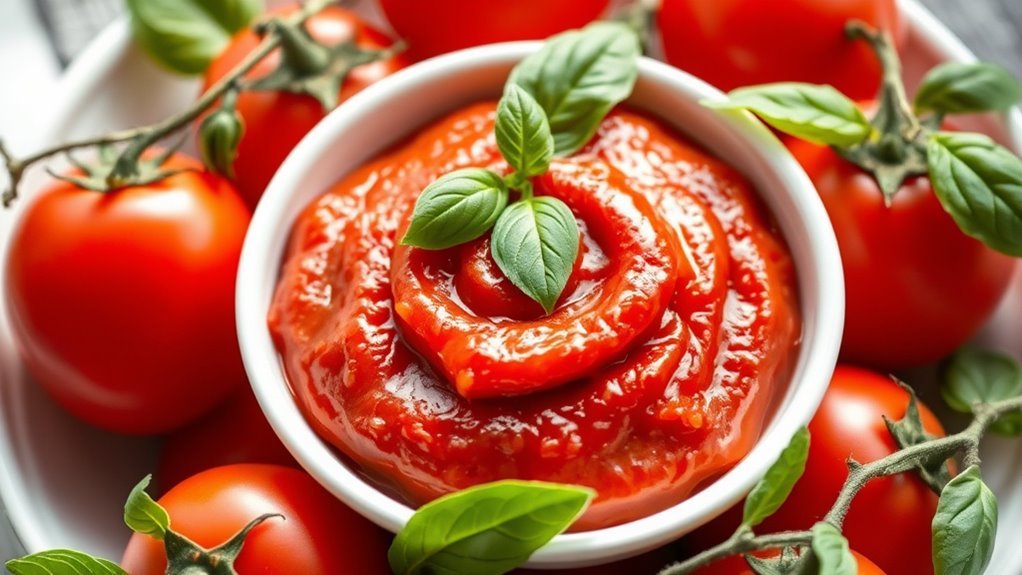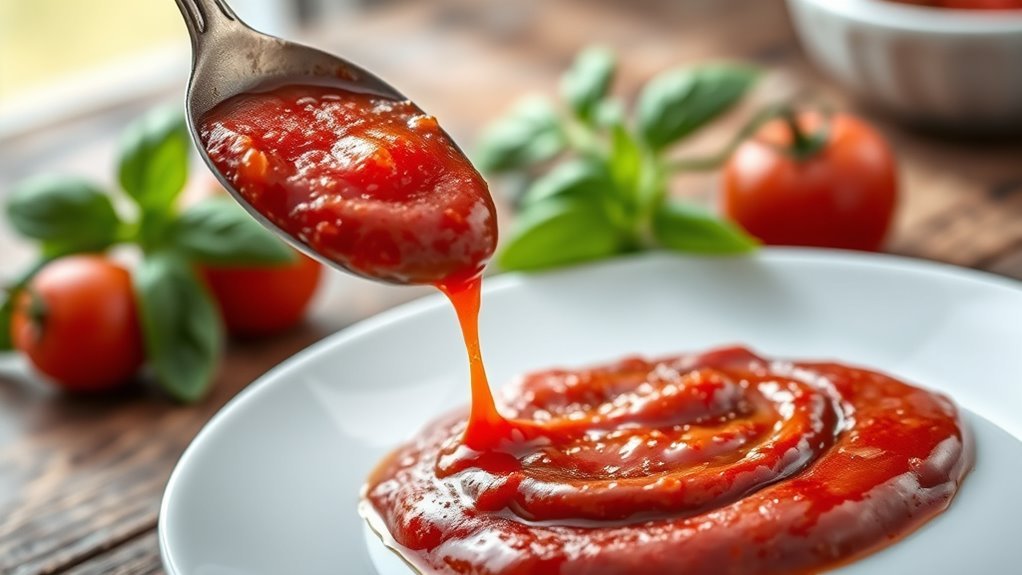Tomato paste can fit into a keto diet, but you need to watch your portions due to its carbohydrate content. Two tablespoons contain about 6 grams of carbs, so it’s essential to measure servings to stay within your daily limits. Compared to other tomato products, it may have a higher carb count, especially those with added sugars. If you’re mindful about the type and amount you use, there are plenty of ways to incorporate it into your meals. You’ll find more tips and recipe ideas ahead.
Understanding the Nutritional Profile of Tomato Paste

When you think about tomato paste, it’s essential to take into account its nutritional profile, especially if you’re following a keto diet. Tomato paste is rich in vitamins A, C, and K, offering significant nutritional benefits. These vitamins support immune function, skin health, and bone density. Additionally, tomato paste contains antioxidants like lycopene, which may contribute to heart health.
For serving suggestions, consider using tomato paste as a base for keto-friendly sauces or soups. You can mix it with herbs and spices to enhance flavors without adding carbs. It’s also great in casseroles or stews, allowing you to enjoy robust flavors while adhering to your dietary preferences. Overall, tomato paste can be a valuable addition to your keto meal plan.
Carbohydrate Content and Serving Size

A typical serving of tomato paste, which is about two tablespoons (30 grams), contains approximately 6 grams of carbohydrates. Understanding serving sizes is essential for accurate carbohydrate calculations, especially on a keto diet. Here’s a clearer picture:
- Two tablespoons (30 grams): 6 grams of carbs
- One tablespoon (15 grams): About 3 grams of carbs
- One cup (240 grams): Roughly 48 grams of carbs
These values highlight how quickly carbs can add up. By managing your serving sizes, you can enjoy tomato paste while sticking to your carb limits. Always check nutrition labels, as brands may vary slightly. This awareness can empower you to make informed choices that align with your keto goals.
Comparing Tomato Paste to Other Tomato Products

Tomato paste isn’t the only tomato product to evaluate on a keto diet, and comparing it with alternatives can help you make better choices. In a tomato sauce comparison, you’ll find that sauces often contain added sugars, increasing their carb count. Canned tomatoes, on the other hand, typically have a lower carbohydrate content and can be a more keto-friendly option. A canned tomatoes analysis reveals they’re versatile and can be used in various dishes while maintaining a lower carb profile than tomato paste. When selecting tomato products, consider the ingredient list and nutritional values to guarantee they align with your keto goals. Additionally, it’s important to note that the nutritional profile of different tomato products can significantly impact your overall carb intake. Ultimately, understanding these differences allows for more informed dietary decisions.
Health Benefits of Tomato Paste
While many focus on the carbohydrate content of tomato paste in a keto diet, it’s important to recognize its numerous health benefits. This nutrient-rich product offers several nutritional advantages that can enhance your overall well-being. Here are three key health benefits:
Many overlook the health benefits of tomato paste; it’s a nutrient-rich addition that enhances overall well-being.
- Rich in Antioxidants: Tomato paste contains lycopene, a powerful antioxidant linked to reducing the risk of chronic diseases.
- Supports Heart Health: The potassium and vitamins in tomato paste can contribute to maintaining a healthy heart by regulating blood pressure.
- Boosts Immunity: With its high vitamin C content, tomato paste helps strengthen your immune system, keeping you healthy.
Incorporating tomato paste into your diet not only adds flavor but also provides these valuable health benefits.
How to Use Tomato Paste in Keto Recipes
Incorporating tomato paste into your keto recipes can elevate both flavor and nutritional value, making your meals more satisfying. You can create delicious keto sauces by mixing tomato paste with olive oil, garlic, and herbs, enhancing the taste of your dishes without adding unnecessary carbs. For pasta alternatives, consider using zucchini or shirataki noodles, and toss them with a rich tomato paste sauce for a comforting meal. You can also add tomato paste to soups or casseroles, enriching them with a concentrated tomato flavor. Just remember to monitor portion sizes, as even small amounts can contribute to your daily carb intake. With these tips, you’ll enjoy flavorful, keto-friendly dishes that keep you on track with your dietary goals.
Potential Drawbacks of Tomato Paste on a Keto Diet
While tomato paste can add flavor to your keto meals, it’s important to take into account its carbohydrate content. A single tablespoon can contain around 3-4 grams of carbs, which may impact your daily intake if you’re not careful. Additionally, the sugar levels in tomato paste can pose challenges for portion control, potentially leading you away from your keto goals. Therefore, it’s essential to monitor your electrolyte intake as you adjust your diet to maintain balance and support your health.
Carbohydrate Content Concerns
Although tomato paste can add rich flavor to dishes, its carbohydrate content raises concerns for those adhering to a strict keto diet. Specifically, consider these factors:
- Carbohydrate Sources: Tomato paste contains around 7 grams of carbs per 2 tablespoons, which can quickly add up.
- Keto Alternatives: You might want to explore options like zucchini puree or cauliflower sauce that are lower in carbs.
- Portion Control: Even small servings of tomato paste can impact your daily carb limit, making it essential to measure carefully.
If you’re aiming for freedom within your keto lifestyle, being mindful of these carbohydrate sources is vital. Balancing flavors while staying within your carb limits can help maintain your progress and dietary goals. Additionally, understanding the carbohydrate content of various ingredients is crucial for successful meal planning on keto.
Sugar Levels Impact
When considering tomato paste on a keto diet, it’s important to recognize that its sugar levels can pose potential drawbacks. Tomato paste contains natural sugars that can impact your overall carbohydrate intake. Even though these sugars come from whole tomatoes, they can still influence your insulin response. Elevated sugar levels can lead to increased insulin production, which may hinder your ability to maintain ketosis. If you’re trying to stay within the strict limits of a keto diet, the sugar impact of tomato paste can complicate your efforts. It’s essential to monitor how much you consume and consider alternatives that align better with your dietary goals. Tomatoes contain about 3-4 grams of net carbs while balancing flavors and nutritional content is key to maintaining freedom in your food choices while adhering to keto principles.
Portion Control Challenges
Even if you enjoy the rich flavor of tomato paste, portion control can become a significant challenge on a keto diet. Since it’s easy to overindulge, keeping an eye on portion sizes is essential. Here are some serving suggestions to help:
- One tablespoon: This is roughly 7 grams of carbs, a manageable amount for your keto plan.
- Two tablespoons: While it enhances flavor, it adds up to about 14 grams of carbs, so use it sparingly.
- Three tablespoons or more: This can quickly exceed your daily carb limit. Additionally, remember that keeping carb intake low is crucial for achieving ketosis.
Tips for Choosing the Right Tomato Paste
When selecting tomato paste, it’s essential to check the ingredients label for any hidden additives or preservatives. Look for options with low sugar content to better align with your keto diet goals. This way, you can guarantee you’re making a healthier choice that fits your nutritional needs.
Check Ingredients Label
How can you guarantee you’re choosing the right tomato paste for a keto diet? Start with ingredient transparency. Perform a thorough label analysis to confirm you’re not compromising your keto goals. Here are three key aspects to look for:
- Short Ingredient List: The fewer the ingredients, the better. Ideally, it should only contain tomatoes and perhaps salt or herbs.
- No Added Sugars: Check for any hidden sugars or sweeteners that can spike your carb count.
- No Preservatives: Avoid any products with artificial additives that could interfere with your health goals. Additionally, always choose products that support a balanced diet to ensure you’re meeting your nutritional needs while staying keto-compliant.
Look for Low Sugar
Are you really aware of how sugar can sneak into your tomato paste? Many brands add sugars to enhance flavor, which can derail your keto goals. When shopping, look for low sugar alternatives that keep your carb count in check. Check the nutrition label for added sugars, aiming for products that have less than 2 grams per serving.
Consider tomato pastes that use natural sweeteners like stevia or erythritol, which can provide a hint of sweetness without affecting your blood sugar levels. Don’t hesitate to experiment with brands; some proudly showcase their low sugar content. By being vigilant, you can enjoy rich, flavorful tomato paste while staying true to your low-carb lifestyle. Additionally, understanding macronutrient ratios is essential for maintaining ketosis and supporting your overall health. Your freedom to choose isn’t just about taste; it’s about health too.
Delicious Keto-Friendly Recipes With Tomato Paste
Tomato paste is a versatile ingredient that can elevate your keto-friendly meals with its rich flavor and low carbohydrate content. Here are three delicious recipes you can try:
- Keto Pasta Sauce: Sauté garlic and onion in olive oil, then add tomato paste, herbs, and spices for a flavorful sauce over zucchini noodles.
- Creamy Tomato Soup: Combine tomato paste with vegetable broth, heavy cream, and your favorite seasonings for a warming bowl of soup—perfect for chilly days.
- Stuffed Bell Peppers: Mix ground meat with tomato paste, cheese, and spices, then stuff into bell peppers and bake until golden.
These recipes not only keep you on track with your keto diet but also let you enjoy meals bursting with flavor and variety. Additionally, using low-carb ingredients ensures that your meals align with your dietary goals.
Frequently Asked Questions
Can I Use Tomato Paste in a Ketogenic Pizza Recipe?
Yes, you can use tomato paste in a ketogenic pizza recipe. It provides a rich tomato flavor while being low in carbs, just be mindful of the portion size. A tablespoon or two can enhance your pizza without greatly impacting your macros. Look for options without added sugars to keep it keto-friendly. Incorporating it into your keto pizza can elevate the taste while still aligning with your dietary goals. Enjoy your pizza creation!
Is Organic Tomato Paste Better for a Keto Diet?
Organic tomato paste can be better for your keto diet due to its organic benefits and enhanced nutrient profile. You’ll find that organic varieties often contain fewer additives and preservatives, which aligns with a cleaner eating approach. Plus, organic tomatoes may have higher antioxidant levels, supporting overall health. When considering keto compatibility, always check for sugar content, but organic options generally offer a wholesome choice that fits well within your low-carb lifestyle.
Does Tomato Paste Contain Added Sugars?
Yes, some tomato paste brands do contain added sugars, which can increase their carbohydrate count. To guarantee you’re sticking to a keto-friendly diet, it’s vital to check the label for added sugar content. Look for options that are labeled “no added sugar” or consider using keto-friendly alternatives like crushed tomatoes or homemade tomato puree. These can provide the flavor you need without compromising your carb limits. Always prioritize quality ingredients!
How Long Does Opened Tomato Paste Last?
Opened tomato paste can be like a ticking clock in your pantry, with a shelf life of about 5 to 7 days in the fridge. To maximize freshness, store it in an airtight container and keep it away from light. If you need more time, consider freezing it in portions; it’ll last up to 3 months that way. By following these storage tips, you can enjoy your tomato paste longer without compromising quality.
Can Tomato Paste Be Frozen for Later Use?
Yes, you can freeze tomato paste for later use. For ideal freezer storage, scoop the paste into ice cube trays or small containers. This method helps preserve flavors while making it easy to use just the right amount later. When stored properly, frozen tomato paste can last up to six months. Just remember to label your containers with the date, so you know when it’s time to use them up!


